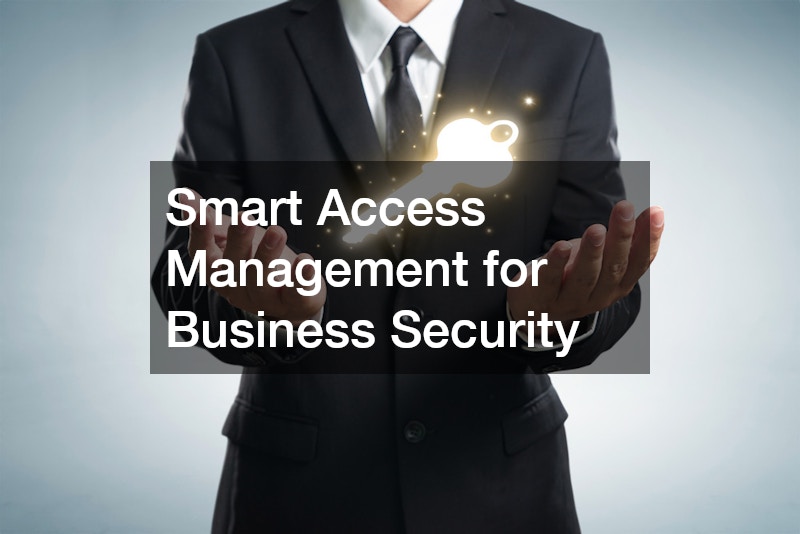In today’s rapidly evolving business environment, ensuring security without compromising convenience is paramount. With the rise of smart technologies, businesses, including professional services companies, are increasingly turning to smart access management systems to safeguard their premises while streamlining operations. These systems offer a modern, efficient approach to securing both physical and digital access points, ensuring businesses remain protected against a wide range of security threats. However, it’s important to also consider the legal issues surrounding smart access management, as companies must ensure compliance with privacy regulations and data protection laws to avoid legal complications.
Streamlining Operations Through Technology
The integration of smart technologies in access management allows businesses to operate more efficiently. By automating access control systems and incorporating advanced technologies such as the Internet of Things (IoT) and Artificial Intelligence (AI), businesses can simplify the management of access rights, track user activities, and ensure that only authorized personnel gain entry to sensitive areas. This technology-driven approach enhances both security and operational workflows, reducing the risk of human error and making the entire process more efficient.
Additionally, cable connectors seals play a crucial role in ensuring the integrity of smart access systems. These seals protect the cables and connectors used in the installation of access control systems, safeguarding them from environmental elements and reducing the risk of system malfunctions.
This article will dive deeper into the components, benefits, and challenges associated with smart access management systems. We will also explore how businesses, including professional services companies, can successfully implement these systems to not only protect their assets but also enhance operational efficiency and prepare for long-term growth.
1. What is Smart Access Management?
1.1 Definition and Overview
Smart access management refers to the integration of advanced technologies to control and monitor access to physical and digital resources within an organization. Unlike traditional systems that rely on physical keys or standalone card readers, smart access management utilizes digital credentials, biometric data, and cloud-based platforms to provide secure and flexible access control.
1.2 Key Components of Smart Access Systems
Key components include digital credentials, which utilize smartphones, RFID cards, or biometric identifiers for authentication; cloud-based platforms that allow centralized management and real-time monitoring of access points; and integration capabilities for seamless integration with existing security systems, such as surveillance cameras and alarm systems.
1.3 Difference Between Traditional and Smart Access
Traditional access systems often involve manual processes, limited scalability, and higher susceptibility to breaches due to lost or stolen keys. In contrast, smart access management offers automated, scalable, and more secure solutions that can adapt to the dynamic needs of modern businesses.
1.4 Importance for Modern Businesses
Implementing smart access management is crucial for businesses aiming to enhance security, ensure compliance with regulations, and improve operational efficiency. It enables organizations to manage access rights dynamically, respond swiftly to security incidents, and maintain detailed audit trails.
1.5 Emerging Trends in Access Management
Emerging trends include the adoption of AI-driven analytics for predictive security, the use of blockchain for immutable access logs, and the integration of IoT devices to create interconnected security ecosystems.
2. How Does Smart Access Management Work?

2.1 Core Technologies Involved
Smart access management systems leverage technologies such as the Internet of Things (IoT) for real-time data exchange, Artificial Intelligence (AI) to analyze access patterns and detect anomalies, and Cloud Computing to provide scalable and remote access management capabilities.
2.2 Integration with Existing Systems
These systems are designed to integrate seamlessly with existing infrastructure, including surveillance systems, fire alarms, and building management systems, ensuring a cohesive security strategy.
2.3 Role of IoT in Access Management
IoT devices play a pivotal role by enabling real-time monitoring and control of access points, facilitating automated responses to security events, and collecting data for analysis.
2.4 Real-time Monitoring and Analytics
Real-time monitoring allows for immediate detection of unauthorized access attempts, while analytics provide insights into access patterns, helping to optimize security protocols and resource allocation.
2.5 Case Studies of Implementation
For instance, a manufacturing facility implemented smart access management to control access to sensitive areas, resulting in a 30% reduction in security breaches. Similarly, a professional services companies integrated smart access systems to streamline visitor management, enhancing client experience and compliance.
3. What are the Benefits of Smart Access Management?
3.1 Enhanced Security Measures
Smart access management provides robust security through multi-factor authentication, real-time alerts, and detailed access logs, significantly reducing the risk of unauthorized access.
3.2 Operational Efficiency
Automating access control processes minimizes administrative tasks, allowing staff to focus on core business activities and improving overall productivity.
3.3 Cost Savings and ROI
While initial investments may be higher, the long-term savings from reduced security incidents, lower administrative costs, and improved operational efficiency offer substantial returns on investment.
3.4 Improved User Experience
Users benefit from seamless access through mobile credentials or biometrics, reducing wait times and enhancing satisfaction.
3.5 Scalability and Flexibility
Smart access systems can easily scale with business growth, accommodating new users, locations, and integrating with additional technologies as needed.
4. What Are the Different Types of Smart Access Control Systems?

4.1 Biometric Access Control
Utilizes unique biological traits, such as fingerprints or facial recognition, offering high security and convenience.
4.2 RFID and Card-based Systems
Employ radio-frequency identification for quick and contactless access, commonly used in office environments.
4.3 Mobile Access Solutions
Allow users to gain entry using smartphones, enhancing flexibility and reducing the need for physical credentials.
4.4 Cloud-based Access Management
Provides centralized control and real-time updates, facilitating remote management and scalability.
4.5 Hybrid Access Control Solutions
Combine multiple authentication methods to enhance security and cater to diverse user preferences. Cable connectors seals play a key role in securing the physical infrastructure of the system. These seals protect the cables and connectors involved in the access control systems.
5. How to Implement Smart Access Management in Your Business?
5.1 Assessing Security Needs
Conduct a thorough assessment to identify critical access points, user requirements, and potential vulnerabilities.
5.2 Choosing the Right System
Select a system that aligns with your business size, industry regulations, and integration capabilities.
5.3 Installation and Training
Ensure professional installation and provide comprehensive training to staff for effective utilization.
5.4 Customization and Configuration
Tailor the system settings to match organizational policies and user roles, enhancing security and usability.
5.5 Ongoing Maintenance and Support
Establish a maintenance schedule and support system to address technical issues and updates promptly.
6. What are the Challenges of Smart Access Management?

6.1 Privacy and Compliance
Collecting and storing personal data necessitates stringent privacy policies and compliance with data protection regulations, particularly when integrated systems like parking access systems are involved. These systems often require the collection of vehicle identification details, driver information, and other personal data, making it crucial for businesses to implement strong privacy protocols. Compliance with laws such as GDPR or CCPA ensures that all personal data is handled appropriately, minimizing the risk of breaches and protecting both the company and its customers.
6.2 Technological Vulnerabilities
As with any digital system, smart access management—including components like parking access systems—is susceptible to cyber threats, requiring robust cybersecurity measures. Hackers could potentially exploit vulnerabilities in the access control network, targeting areas where sensitive data or physical security are at stake. By ensuring that cybersecurity protocols are up to date, businesses can safeguard these systems from attacks, ensuring both their physical and digital assets remain secure.
6.3 System Integration Issues
Integrating new systems with legacy infrastructure can pose compatibility challenges, necessitating careful planning.
6.4 Cost Barriers
The initial investment may be substantial, potentially deterring small businesses from adoption.
6.5 Resistance to Change
Employees may be hesitant to adopt new technologies, highlighting the need for effective change management strategies.
7. How Does Smart Access Management Foster Compliance?
7.1 Understanding Compliance Regulations
Smart access systems assist in adhering to industry-specific regulations by controlling and monitoring access to sensitive areas, which is critical for businesses like local phone repair services that handle sensitive customer data and valuable equipment. Compliance with industry standards ensures that access to repair areas, inventory, and customer information is carefully managed to prevent unauthorized access and potential data breaches.
7.2 Data Protection and GDPR
Implementing features like data encryption and user consent mechanisms ensures compliance with data protection laws such as GDPR. For local phone repair services , where customer information is collected for repairs and diagnostics, it’s particularly important to safeguard this data. Secure access to data repositories and repair logs not only protects the business but also ensures customer trust and regulatory compliance.
7.3 Audit Trails and Reporting
Comprehensive logs and reporting capabilities facilitate audits and demonstrate compliance with regulatory requirements. Local phone repair services benefit from maintaining clear, secure records of who accessed specific repair areas and customer data, which can be vital in case of an audit or regulatory inspection.
7.4 Ensuring Industry Standards
Aligning access control practices with industry standards enhances credibility and reduces legal risks. For local phone repair services , adhering to industry standards for customer data security, equipment handling, and repair processes can improve reputation, ensure smooth operations, and prevent potential legal challenges.
7.5 Collaboration with Regulatory Bodies
Engaging with regulatory authorities during implementation can provide guidance and ensure alignment with compliance expectations. For local phone repair services , working with industry regulators ensures that access control systems not only meet legal obligations but also optimize operations for security and efficiency.
8. How Does Smart Access Management Enhance User Experience?

8.1 Simplified Authentication Processes
Streamlined authentication methods, such as mobile credentials, reduce friction and improve user satisfaction.
8.2 Personalization of User Access
Customized access rights based on roles enhance security and user convenience.
8.3 Faster Entry and Exit
Automated access reduces wait times, particularly in high-traffic areas, improving overall efficiency.
8.4 Advanced Notification Systems
Real-time notifications alert users to access events, enhancing awareness and security.
8.5 User-friendly Interfaces
Intuitive interfaces facilitate ease of use, encouraging adoption and reducing training requirements.
9. Are There Risks Associated with Smart Access Management?
9.1 Data Breach Risks
Unauthorized access to stored data poses significant risks, necessitating robust encryption and access controls.
9.2 Physical Security Risks
Reliance on digital systems may lead to vulnerabilities if physical security measures are neglected.
9.3 System Downtime Concerns
Technical failures can disrupt access, highlighting the need for reliable infrastructure and contingency plans.
9.4 Insider Threats
Employees with malicious intent may exploit access privileges, underscoring the importance of monitoring and audits.
9.5 Mitigation Strategies
Implementing comprehensive security policies, regular audits, and employee training can mitigate these risks effectively.
10. What is the Future of Smart Access Management?
10.1 Technological Advancements
As businesses continue to evolve, smart access management will incorporate advancements in AI, machine learning, and blockchain technologies to improve security, predictive analytics, and data integrity. Additionally, the involvement of wireless infrastructure companies will play a pivotal role in facilitating the seamless connectivity needed for these advanced systems. The future will also see the integration of even more seamless and user-friendly access methods, such as facial recognition, voice-based access, and more.
The Growing Need for Smart Access Management
As businesses continue to expand, evolve, and become more interconnected, the demand for effective security solutions has never been higher. Executive office, along with other critical business areas, require specialized security measures to protect sensitive information and assets. Smart access management stands firmly at the forefront of security innovation, offering businesses a comprehensive and dynamic way to protect their physical and digital assets. With rapid technological advancements and evolving business models, smart access management plays an essential role in ensuring that security measures can keep pace with changing needs and threats.
Enhancing Security Through Advanced Technologies
By combining cutting-edge technologies such as biometric authentication, cloud-based platforms, and real-time monitoring, companies can safeguard their premises, networks, and intellectual property more effectively. This is particularly important for executive office, which often house confidential documents, strategic plans, and high-level discussions. The integration of these technologies ensures that both physical and digital assets are continually monitored and protected. With smart access management systems, businesses can offer flexible, yet secure access controls that meet the needs of remote workforces, multiple locations, and evolving security protocols, including critical areas like executive offices.
Promising Integration with Other Smart Technologies
The continued evolution of smart access management systems promises to integrate seamlessly with other smart technologies, further enhancing business operations. For example, the integration with Internet of Things (IoT) devices, artificial intelligence (AI) for predictive analysis, and blockchain for secure and transparent access logs will provide businesses with even more robust and comprehensive security measures. The future of business security lies in a fully interconnected ecosystem, where access control, environmental monitoring, and operational data are all seamlessly integrated into a unified system.
These evolving technologies will allow businesses to implement even more sophisticated solutions that can dynamically respond to potential security threats in real-time, ensuring that both employees and assets are always secure.
Streamlining Operations for Increased Efficiency
Smart access management systems are not only about security but also about improving overall operational efficiency. With automated access control, businesses can streamline their internal processes, reduce manual tasks, and eliminate human error. Real-time data reporting, automated updates, and system scalability enable businesses to focus on their core operations, ensuring greater productivity and cost efficiency.
Furthermore, smart access management systems can automate scheduling, control access across multiple locations, and enhance the overall user experience by providing seamless entry without compromising on security. This level of integration helps businesses maximize their resources and reduce costs related to manual security management.
Positioning Businesses for Long-Term Success
The implementation of smart access management today is not just a short-term security solution, but a long-term investment that positions businesses for success in the future. As companies face increasingly complex and dynamic security landscapes, adopting smart access management systems will become a vital part of remaining competitive and secure. In addition to these systems, battery backup storage ensures that critical security infrastructure remains operational, even during power outages, enhancing the overall reliability of security measures.
By adopting these systems now, businesses can future-proof their security measures, ensuring that they stay ahead of emerging threats while remaining agile in an ever-changing business environment. The continued evolution and integration of smart access management technologies will enable businesses to manage their security systems more effectively, allowing for more flexible, scalable, and secure business operations.
A Strategic Advantage for Modern Businesses
In conclusion, the adoption of smart access management offers a significant strategic advantage for businesses of all sizes. It provides robust security, improved operational efficiency, and a forward-thinking approach to managing access in a rapidly evolving digital world. The future of business security will undoubtedly be shaped by the ongoing innovation in smart access management, enabling companies to stay secure, operationally efficient, and ready to adapt to the challenges of tomorrow. Businesses that implement these systems today will be better positioned for success, security, and growth in the years to come.






